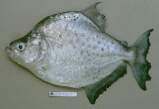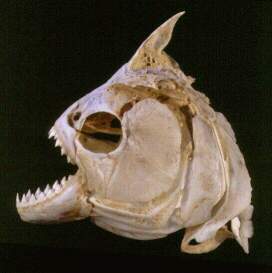


William L. Fink: Research Profile for the Department of Ecology and Evolutionary Biology
Pgygocentrus nattereri
| Pygocentrus nattereri |  |
| Serrasalmus elongatus |  |
| Serrasalmus altuvei |  |
| Typical piranha shapes |

|
This skull is from a Pgygocentrus nattereri from the Amazon river basin. This species is commonly known as the "red-bellied" piranha, and has a reputation as being a ferocious predator, whose food choices include humans. But piranhas are actually much more interesting that this single species. There are over 60 described species of piranhas, but how many actually exist is not known. Bill Fink's work involves trying to determine the number of species, but also how they are interrelated, how they have evolved over the past 40 million years or so, and how they "fit" in their ecosystems. A major part of this research program is understanding the evolution of shape in these fishes. Piranhas have a wide variety of body shapes, some of which seem to be correlated with diet. For example some species have very slender-bodied juveniles who specialize on eating fins and scales of other fishes. In the lab, means of describing and quantifiying shapes of piranhas are being explored, as well as how shapes change during the development of individuals from juveniles to adults. Also of interest is how these developmental pathways evolve, giving rise to the diversity of body shapes seen in piranhas today. Shape analysis involves digital capture of images and then acquisition of data from landmarks on the body of the specimen. These data are analyzed by several methods, including "traditional" morphometrics (concerned with lengths and widths of parts of the body), and geometric morphometrics (concerned with landmark coordinates). In a recent analysis of piranha shape evolution, juveniles were found to have a greater diversity of body shapes than adults. Although it is commonly assumed that early ontogenetic stages are more conservative than those that follow later, diversity actually drops when these fishes move from juvenile stages to adults. This increase in juvenile diversity is the result of a highly modified juvenile shape in one of the lineages included in the study. The scatterplot below illustrates this diversity in a principal components analysis.
|
|
Landmarks used in the analysis of piranha body shape
Typical trusses used in a traditional study
Deformation grids from a geometric study
|